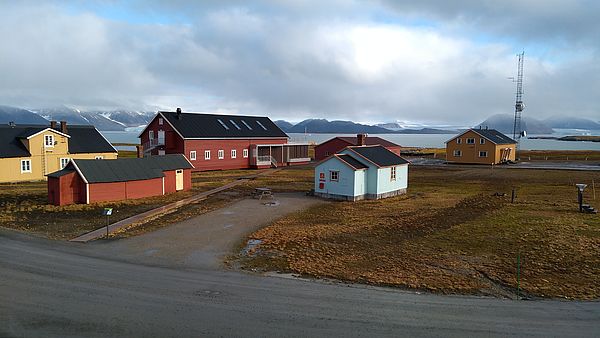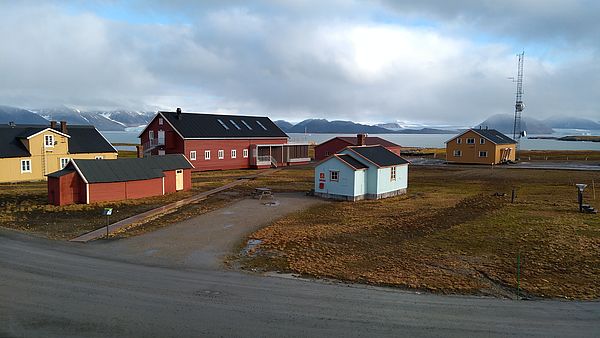
Background
SIOS4 | |
NIPR observatory, Ny-Ålesund | |
Arctic | |
Open | |
Station | |
Japan | |
None | |
2019 |
Introduction
The NIPR Observatory is part of the building Kings Bay Veksthus and is operated by the Arctic Environment Research Center (AERC) of the National Institute of Polar Research (NIPR). | |
The NIPR observatory is located centrally in Ny-Ålesund Research Station, on the shores of Kongsfjorden on the west coast of Spitsbergen, the largest island of the Svalbard archipelago. | |
Ny-Ålesund is surrounded by tundra vegetation and river plains, on the otherwise mountainous Brøgger peninsula. The areas to the south, east and north of Ny-Ålesund are glaciated. Reindeer and foxes are frequently seen in the area, which is also visited by large number of migratory birds during the summer season. Polar bears are infrequent visitors, while seals, walrus and beluga whales may be seen in the fjord. | |
Ny-Ålesund was a mining settlement until the 1960's, after which it became an international hub for scientific research. NIPR has had a permanent presence there since 1990. The Japanese activity officially moved from the previous location at Rabben, near the airport, to the new building Kings Bay Veksthus in 2019. The new observatory contains office space, labs and accommodation for visiting researchers. Kings Bay AS owns and manages the facilities in Ny-Ålesund, and provides additional accommodation, food, laboratories and workshops, equipment hire, safety training and runs a small shop and post office. High speed broadband internet is available, but Ny-Ålesund is a radio silent area so mobile phones, WiFi and bluetooth are not allowed. | |
The scientific focus of the AERC is sea ice study, oceanography, marine ecology, terrestrial ecology, atmospheric science, glaciology, and upper atmospheric science. Data may be accessed via the Arctic Data Archive System: ads.nipr.ac.jp/portal/index.action | |
Around 30 people live permanently in Ny-Ålesund and keep the research station running all year. The population increases to its peak in spring and summer time, with around 100-150 researchers and technicians coming for short or long stays. There are no inhabitants not affiliated with research activity, and visits from those not linked with research are strictly regulated. Tourists visit the settlement by boat during the summer, but are not permitted to stay in Ny-Ålesund. | |
Ny-Ålesund has a small airport with a regular flight connection with Longyearbyen (2 flights per week). The flight takes 20-30 minutes and has space for 14-16 passengers. It is also possible to charter flights between Ny-Ålesund and Longyearbyen. Longyearbyen airport has regular flights to and from the Norwegian mainland (Oslo and Tromsø). It is also possible to arrive in Ny-Ålseund by ship, normally between May and October depending on ice conditions. There is no regular boat transport, but tour companies based in Longyearbyen can provide boat transport by request. |
Operator
Arctic Environment Research Center (AERC) of the National Institute of Polar Research (NIPR) | |
Other | |
Inter-University Research Institute | |
Arctic Environment Research Center (AERC) of the National Institute of Polar Research (NIPR) | |
aerc-kikaku@nipr.ac.jp | |
Data Source
Partner Institution
No data |
Location
SIOS4 | |
78° 55' 29'' N | |
11° 55' 56'' E | |
European Arctic | |
6 | |
0 | |
1000 | |
Ny-Ålesund | |
0 | |
1.3 | |
Other | |
Permafrost |
Climate
Continuous | |
High Arctic | |
Snow and Rain | |
370 | |
14 | |
90 | |
E | |
1969 | |
-6.4 | |
-14.1 | |
-15.2 | |
-14.6 | |
-11.3 | |
-4.2 | |
1.4 | |
4.7 | |
3.9 | |
-0.1 | |
-5.6 | |
-9.6 | |
-12.5 | |
May; June; July; August; September; October |
Features
Bird colonies; Clear air zone; Coast; Crevasse; Fauna; Fjord; Ice cap or glacier; Lake; Low artificial light pollution; Melt streams; Mountain; Rivers; Sea; Sea ice; Tundra |
Disciplines
Atmospheric chemistry and physics; Atmospheric sciences; Biology; Climate studies; Climate change; Earth and atmospheric sciences–other; Ecology; Geophysics and seismology; Glaciology; Oceanography | |
The upper atmosphere, the aurora and the Earth’s magnetic field. |
Human Activities
Yes | |
The first human settlement was established in 1916 when the first coal mine was opened by Kings Bay Kull Compani AS. Coal mining continued to be the main activity in the area until the final mine was closed in 1963 after a series of tragic accidents. The first satellite telemetry station in Ny-Ålesund operated between 1967 and 1974. In the 1990's the area became increasingly attractive for international researchers, and institutions from several countries established a permanent presence during this time. | |
Yes | |
Yes | |
Yes | |
Yes |
Infrastructure
SIOS4 | |
Biology; Geophysics | |
Yes | |
Yes | |
Fossil fuel | |
24 |
Staff Capacity
Scientific Equipment
Instruments for monitoring atmospheric chemistry and physics, including upper atmosphere physics | |
Vegetation, atmosphere, glaciology, sea-ice |
Medical Facilities
Yes | |
Nurse | |
0 | |
115 | |
1 | |
No |
Vehicles
Boat | |
Snowmobile, car (around the settlement only) |
Workshop facilities
Mechanical; Wood workshop |
Communications
Computer; E-mail; Internet; Printer; Satellite phone; Telephone; VHF |
Access
SIOS4 | |
Air; Land; Sea |
Aircraft landing facilities
1 | |
Airport for small aircraft | |
Permanent | |
Yes |
Transport and freight
Airplane; Helicopter; Ship | |
April; May; June; July; August; September; October; November; December | |
Port | |
150 | |
January; February; March; April; May; June; July; August; September; October; November; December |
Access To The Facility
Yes | |
Various permits may be required depending on the nature of the work. | |
aerc-kikaku@nipr.ac.jp | |
Pictures
 NIPR observatory, Kings Bay. Vektshus with Post Office in foreground (Credit: D Ignatiuk) |
